
While I was exposed to the Bloody Roar franchise first with Bloody Roar Primal Fury on the Nintendo Gamecube (as my brothers had that game and I played it a lot with them), the second Bloody Roar game that I played not too long after AND that I also have many memories playing with my brothers and cousins is Bloody Roar 2 for the Playstation.
For this brief review, I will be playing and using screenshots from the arcade version (through MAME 0.230), but the Playstation version is practically the same as this as it keeps the same gameplay and even the same high resolution with 60fps, though the PS1 port does include a handful of extras.
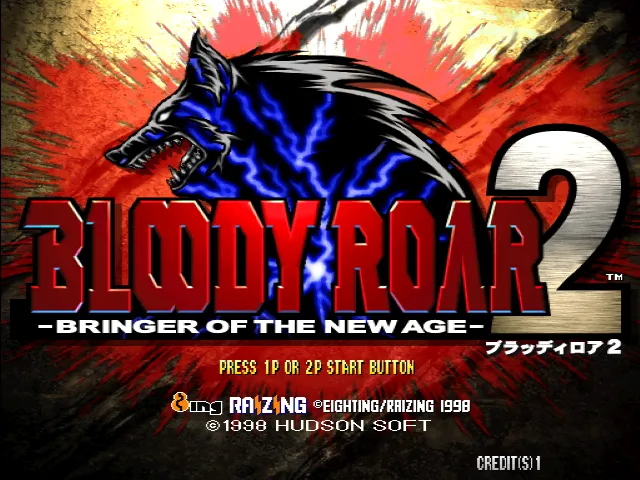
For anybody that hasn't heard about Bloody Roar before, it was another competitor in the 3D fighting game field back when Namco's offerings weren't the only recognizable games in this style, and its primary gimmick was being able to transform into a humanoid beast for both the cool factor and access to more attacks. Each character had an unique moveset and a specific animal transformation, and they range from sort of expected (like a wolf, a rabbit, a cat, and a tiger) to crazier ones (like a ninja mole, a chameleon, and a huge beetle).
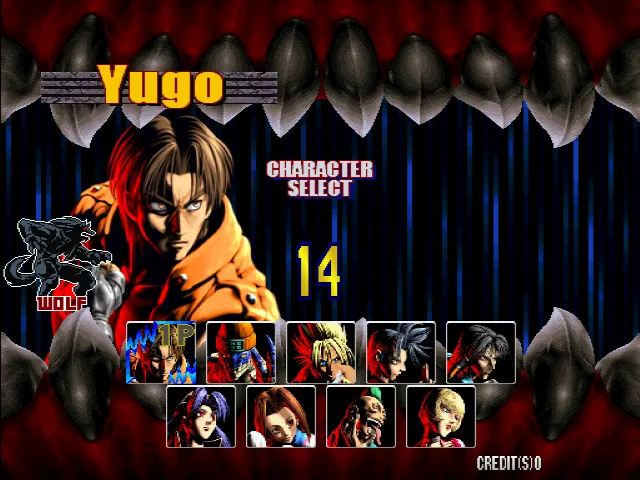
You have 4 buttons avaliable: Punch, Kick, Beast and Guard. On top of your average fighting game commands for special attacks,o ne particular type of attack called "Guard Attack" is often done by using quarter-circle back + punch/kick (depending of the character), which is highlighted by a blue electric effect and can absorb attacks. The controls remind me a bit of Fighting Vipers, as the game does have some basic strings, neutral guard (block without moving or holding Block), a parry-like sidestep if you double tap forward while neutral guarding a move, and guard break moves (highlighted by a spark effect and sound) that break neutral guard (must hold back or Block for these).
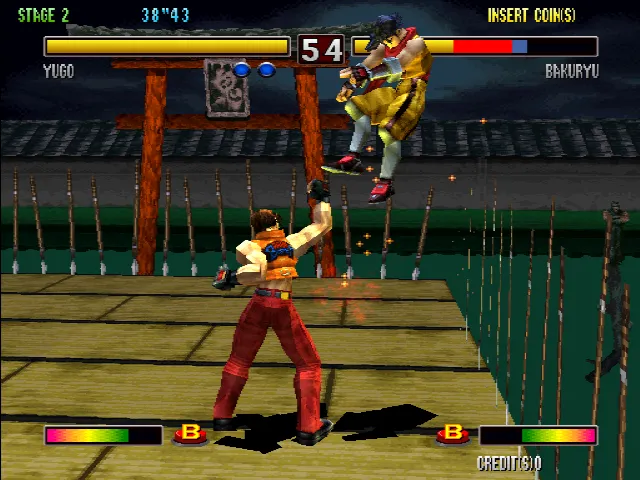
If your Beast Gauge is ready (rainbow colors), you can hit the Beast button to transform and gain access to use this button for unique attacks, extra damage and slowly recovery blue health, but if your Beast Gauge gets depleted by getting hit too much, you'll have to replenish a blue bar in order to be able to transform again. As a Beast, you also gain access to use a Beast Drive (super attack) by either inputting a special command specific to the character, or by pressing Punch + Kick + Beast at the same time for an universal shortcut (the damage will be reduced if you use it this way); but either if you hit it or miss it (or get interrupted), you'll insantly deplete your Beast Gauge.
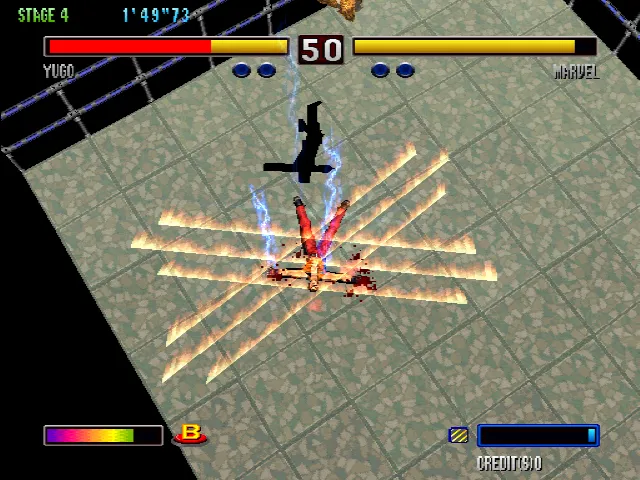
The game does keep a slick yet simple presentation with a high resolution display (which is neat considering it runs in PS1-based hardware) with basic stages and fitting music for each one, and the combats can be quite fast-paced with damaging combos, grabs and landing Beast Drives can quickly spell disaster for you or your opponent, and the characters are given a lot of unique personality, enhanced by their designated transformations and crunchy sound effects. Characters can be sent off flying with strong strikes, which can even break walls in open stages if they are done at the last round needed to win. I consider that, even if some might say that it could be lacking in substance, the style poured in here can make great first impressions.
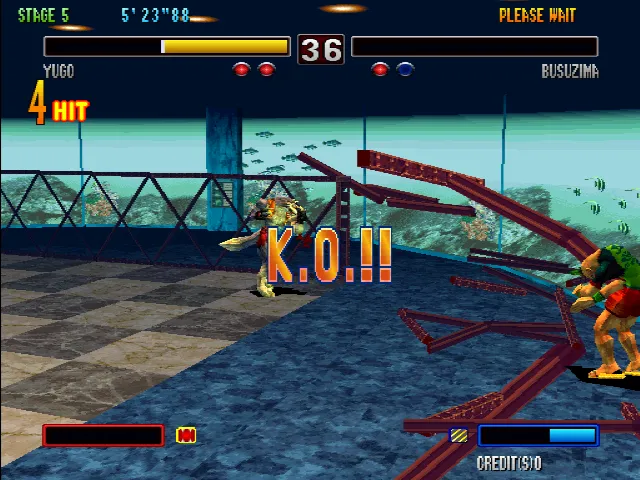
The first game had Gado the Lion as one of the main characters, while Uriko was brainwashed and turned into the game's final boss, being rescued after the end of that game. Here, Uriko is called "the Half-Beast" as she can't complete her transformation into her boss form and is left as a cat (and is a normal playable character), while Gado takes the place as this game's menacing final boss. While Marvel/Shina acts as his replacement as a normal character and keeping all his moves from BR1, Gado gains more strength over agility to make him a boss to not take lightly.
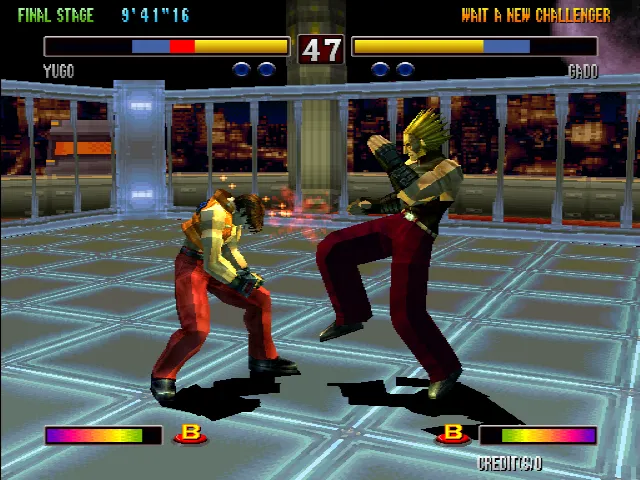
There's also the secret boss Shenlong, an evil clone of Long that uses his moveset from BR1, and can only be faced by completing the Arcade mode without using any continues. Both Gado and Shenlong are unlockable in the both versions, but while the PS1 port only requires you to defeat them, they are time-locked characters in the Arcade version (only avaliable by leaving the machine running for enough time or using a cheat in MAME).
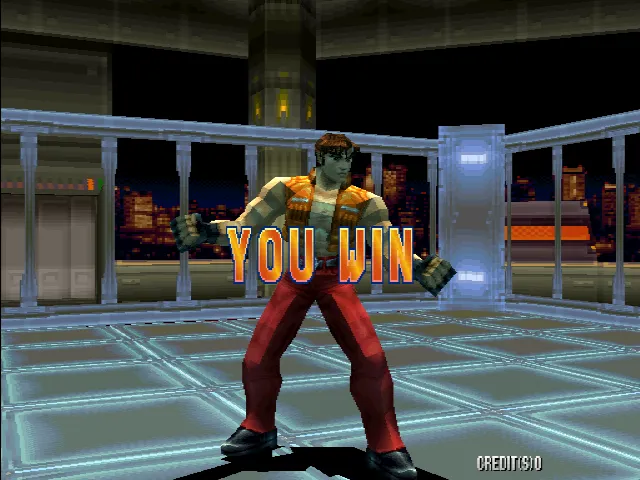
While it might not have caught a lot of attention from the world when it was released and being left in obscurity to the mainstream eyes, despite its simplicity compared to some other fighting games (including the later BR entries), Bloody Roar 2 is still considered a PS1 classic by many, and is another cherished entry for the dedicated Bloody Roar fans out there. However, there's definitely some few interesting things that could be talked about the Playstation version one day, specifically an extra toggle that seems a bit popular for some players to fight with.
But in any case, thank you so much for reading! If you'd like to see more arcade game reviews (or if you want me to review the other Bloody Roar games soon), let me know at the comments; revisiting Bloody Roar 2 was pretty fun so I'd love to do more like this!
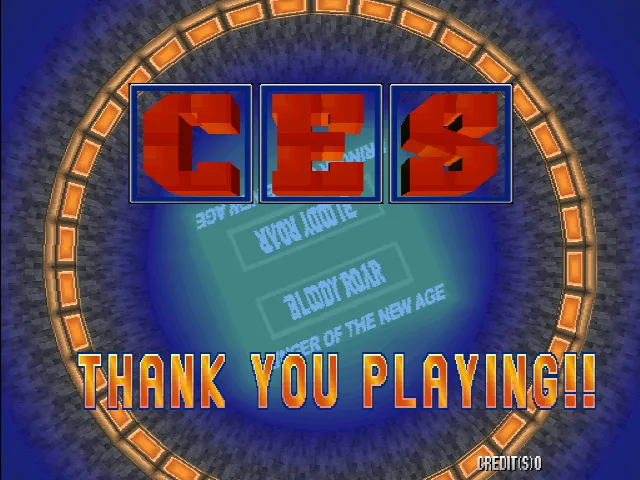
Spanish translation with DeepL. All screenshots were captured by myself.
Español
Si bien conocí la franquicia Bloody Roar primero con Bloody Roar Primal Fury en la Nintendo Gamecube (ya que mis hermanos tenían ese juego y lo jugué mucho con ellos), el segundo juego de Bloody Roar que jugué no mucho después Y del que también tengo muchos recuerdos jugando con mis hermanos y primos es Bloody Roar 2 para la Playstation.
Para esta breve reseña, jugaré y utilizaré capturas de pantalla de la versión arcade (a través de MAME 0.230), pero la versión de Playstation es prácticamente la misma ya que mantiene la misma jugabilidad e incluso la misma alta resolución con 60fps, aunque el port de PS1 incluye un puñado de extras.

Para quien no haya oído hablar de Bloody Roar, se trata de otro competidor en el campo de los juegos de lucha en 3D, cuando las propuestas de Namco no eran los únicos juegos reconocibles de este estilo, y su principal atractivo era poder transformarse en una bestia humanoide, tanto por el factor cool como por el acceso a más ataques. Cada personaje tenía un conjunto de movimientos único y una transformación animal específica, y van desde lo más esperado (como un lobo, un conejo, un gato y un tigre) a otros más locos (como un topo ninja, un camaleón y un enorme escarabajo).

Tienes 4 botones disponibles: Puñetazo, Patada, Bestia y Guardia. Además de los comandos habituales de los juegos de lucha para los ataques especiales, un tipo particular de ataque llamado "Ataque de Guardia" se realiza a menudo utilizando un cuarto de círculo hacia atrás + puñetazo/patada (dependiendo del personaje), que se destaca por un efecto eléctrico azul y puede absorber los ataques. Los controles me recuerdan un poco a los de Fighting Vipers, ya que el juego tiene algunas cuerdas básicas, guardia neutral (bloqueo sin moverse o manteniendo el bloqueo), un paso lateral similar a un parry si tocas dos veces hacia delante mientras estás en guardia neutral, y movimientos de ruptura de guardia (resaltados por un efecto de chispa y sonido) que rompen la guardia neutral (debes mantener la espalda o el bloqueo para estos).

Si tu medidor de bestia está listo (colores del arco iris), puedes pulsar el botón de bestia para transformarte y acceder a usar este botón para realizar ataques únicos, daño extra y recuperar lentamente la salud azul, pero si tu medidor de bestia se agota por recibir demasiados golpes, tendrás que reponer una barra azul para poder transformarte de nuevo. Como Bestia, también tienes acceso a usar un Beast Drive (superataque), bien introduciendo un comando especial específico del personaje, o bien pulsando Puñetazo + Patada + Bestia al mismo tiempo para obtener un atajo universal (el daño se reducirá si lo usas de esta manera); pero tanto si lo golpeas como si lo fallas (o te interrumpen), agotarás insistentemente tu Beast Gauge.

El juego tiene una presentación elegante pero sencilla, con una pantalla de alta resolución (lo que está muy bien teniendo en cuenta que se ejecuta en hardware basado en PS1), con escenarios básicos y música adecuada para cada uno, y los combates pueden ser bastante rápidos con combos dañinos, los agarres y el aterrizaje de los Beast Drives pueden significar rápidamente un desastre para ti o para tu oponente, y los personajes tienen mucha personalidad única, reforzada por sus transformaciones designadas y sus crujientes efectos de sonido. Los personajes pueden salir volando con fuertes golpes, que pueden incluso romper paredes en escenarios abiertos si se hacen en el último asalto necesario para ganar. Considero que, aunque algunos puedan decir que puede carecer de sustancia, el estilo vertido aquí puede causar una gran primera impresión.

El primer juego tenía a Gado el León como uno de los personajes principales, mientras que a Uriko le lavaron el cerebro y lo convirtieron en el jefe final del juego, siendo rescatado tras el final del mismo. Aquí, Uriko es llamada "la media bestia", ya que no puede completar su transformación en su forma de jefe y queda como gato (y es un personaje jugable normal), mientras que Gado ocupa el lugar como el amenazante jefe final de este juego. Mientras que Marvel/Shina actúa como su sustituto como personaje normal y manteniendo todos sus movimientos de BR1, Gado gana más fuerza que agilidad para convertirlo en un jefe al que no hay que tomar a la ligera.

También está el jefe secreto Shenlong, un clon malvado de Long que utiliza su conjunto de movimientos de BR1, y al que sólo se puede hacer frente completando el modo Arcade sin usar ninguna continuación. Tanto Gado como Shenlong son desbloqueables en ambas versiones, pero mientras que en la versión de PS1 sólo hay que derrotarlos, en la versión Arcade son personajes bloqueados por el tiempo (sólo se puede acceder a ellos dejando la máquina en marcha el tiempo suficiente o utilizando un truco en MAME).

Aunque puede que no haya llamado mucho la atención del mundo cuando salió a la venta y que haya quedado en la oscuridad a los ojos de la corriente principal, a pesar de su simplicidad en comparación con otros juegos de lucha (incluidas las entradas posteriores de BR), Bloody Roar 2 sigue siendo considerado un clásico de PS1 por muchos, y es otra entrada apreciada por los fans dedicados de Bloody Roar que hay. Sin embargo, hay algunas cosas interesantes de las que se podría hablar en la versión de Playstation algún día, en concreto un botón extra que parece un poco popular para algunos jugadores a la hora de luchar.
Pero en cualquier caso, ¡muchas gracias por leer! Si quieres ver más análisis de juegos arcade (o si quieres que analice los otros juegos de Bloody Roar pronto), dímelo en los comentarios; ¡revisar Bloody Roar 2 fue muy divertido, así que me encantaría hacer más cosas como esta!

Traducción al español hecha con DeepL. Todas las fotos capturadas por mí.